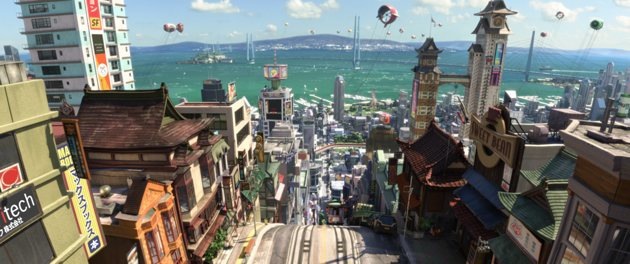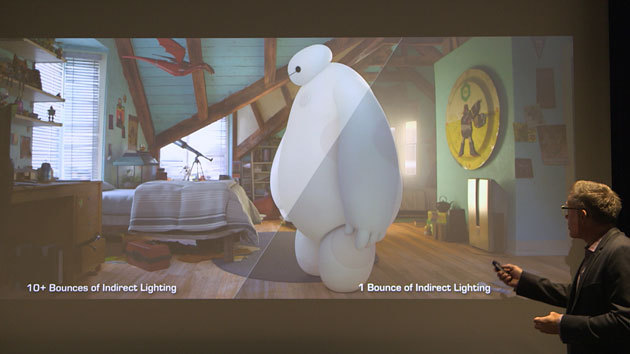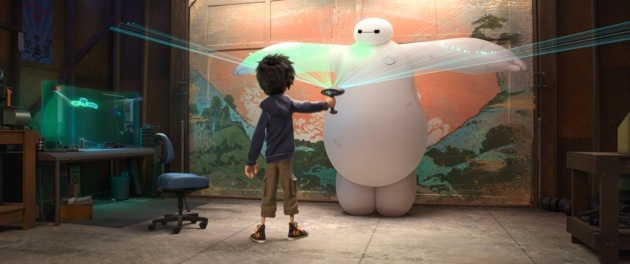New Disney cartoon rendered on 55,000 cores

City of San Fransokio: 83,000 buildings, 260,000 trees, 215,000 street lamps, 100,000 cars
A few days before the premiere of the cartoon “City of Heroes” (Big Hero 6), employees of Walt Disney Animation Studios made a technical presentation and declassified some details of this interesting project. It is interesting not only because it presents 3D printing, telepathically controlled swarm microbots and other technologies of the future, but because quite unique programs have been developed specifically for this film.
In total, the animators used about 30 programs. Some are improved versions of previous designs. But there were also completely new ones. The main one is a global lighting simulator called Hyperion, his group of 10 developers has been creating for about two years.
')
Walt Disney Animation Studios calls Hyperion the riskiest and most ambitious animated R & D project out of everything they did. The main risk was that Hyperion was created on the go. The film, by and large, was rendered on a beta version of the program, until its final readiness.
Hyperion includes a global illumination simulator that performs complex calculations to calculate the multiple reflections of indirect light from all visible surfaces. In particular, Hyperion is able to calculate 10-20 reflections, which creates a realistic effect of lighting in reflected light. Although the majority of the audience of the cartoon will not give it much importance, but the backlight in reflected light is a really powerful thing that no one has done before.

Comparison of rendering with the calculation of one reflection (right) and 10+ reflections (left)
For such calculations, Disney needed gigantic computing power. A cluster of 55,000 computing cores was used, geographically distributed over four render farms . Especially for the management of the cluster was written a separate program called Coda.
The cluster capacity is 1.1 million render-hours per day. 190 million render-hours were spent on the entire film (108 minutes, i.e. 155,520 frames).
To assess the power of the computing system, employees explain that she could have rendered the whole Rapunzel cartoon (2010) in just 10 days.
But here it had to be more complicated: the City of Heroes of San Francochio consists of 83,000 buildings, 260,000 trees, 215,000 street lamps and 100,000 cars, and thousands of people who were generated by another Denizen program. Tellingly, the city map is based on a real San Francisco map.
Employees of Walt Disney Animation Studios say that the animation of such a large city is impossible on the previous generation of technology.
The plot of the film develops in the near future. The main characters are a boy and a soft vinyl robot Beymaks (as well as a group of his friends with supernormal abilities). The boy Hiro Hamada is a born inventor and genius for designing robots. Together with his elder brother Tadashi, they bring to life the most advanced ideas at the Technical University of the city of the future, San Fransokio, which combines the features of San Francisco and Tokyo. After a series of mysterious events, friends find themselves in the center of an insidious conspiracy. Desperate, Hiro decides to use the fun and good-natured experimental robot Beimaks, reprogramming it into an invulnerable fighting machine.
On the frame below, Hiro scans the robot for 3D printing of its armor.

The plot of the film includes many futuristic details. When it was decided to create a story about the technologies of the near future, the director's assistants paid visits to the Massachusetts Institute of Technology, Harvard, Carnegie Mellon University and Tokyo University to get acquainted with advanced developments in robotics and related fields.
For example, the moment in the film, when Hiro prints on the 3D printer in his garage, a protective case for the robot, the film producer considers to be a reference to the DIY maker movement, which is now gaining popularity all over the world.
Soft robot Beymaks also has real types. In particular, robots for patient care are now used in some hospitals in Japan. They have something similar in appearance, although they are made not of vinyl, but of plastic.
Swarm mini-drones are borrowed from research projects at Carnegie Mellon University. Although the version of the cartoon, of course, is more fantastic than the existing prototypes. Electromagnetic microbots transmit a signal along a chain to each other, moving as a whole. Since the swarm includes tens of millions of microbots, it was not possible to render it from the very beginning, until a supercomputer with 55,000 cores was used.
The creators are confident that Big Hero 6 is literally saturated with the love of technology. “The film glorifies science and technology in ways we have never really done before,” says assistant director Don Hall.
Source: https://habr.com/ru/post/241171/
All Articles